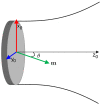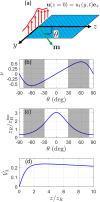Nonlinear propagation of quasiplanar shear wave beams in soft elastic media with transverse isotropy
- PMID: 37184300
- PMCID: PMC10188206
- DOI: 10.1121/10.0019358
Nonlinear propagation of quasiplanar shear wave beams in soft elastic media with transverse isotropy
Abstract
Model equations are developed for shear wave propagation in a soft elastic material that include effects of nonlinearity, diffraction, and transverse isotropy. A theory for plane wave propagation by Cormack [J. Acoust. Soc. Am. 150, 2566 (2021)] is extended to include leading order effects of wavefront curvature by assuming that the motion is quasiplanar, which is consistent with other paraxial model equations in nonlinear acoustics. The material is modeled using a general expansion of the strain energy density to fourth order in strain that comprises thirteen terms defining the elastic moduli. Equations of motion for the transverse displacement components are obtained using Hamilton's principle. The coupled equations of motion describe diffraction, anisotropy of the wave speeds, quadratic and cubic plane wave nonlinearity, and quadratic nonlinearity associated with wavefront curvature. Two illustrative special cases are investigated. Spatially varying shear vertical wave motion in the fiber direction excites a quadratic nonlinear interaction unique to transversely isotropic soft solids that results in axial second harmonic motion with longitudinal polarization. Shear horizontal wave motion in the fiber plane reveals effects of anisotropy on third harmonic generation, such as beam steering and dependence of harmonic generation efficiency on the propagation and fiber directions.
© 2023 Acoustical Society of America.
Figures





References
-
- Norris A. N., “ Finite-amplitude waves in solids,” in Nonlinear Acoustics, edited by Hamilton M. F. and Blackstock D. T. ( Acoustical Society of America, Melville, NY, 2008), Chap. 9.
Grants and funding
LinkOut - more resources
Full Text Sources

